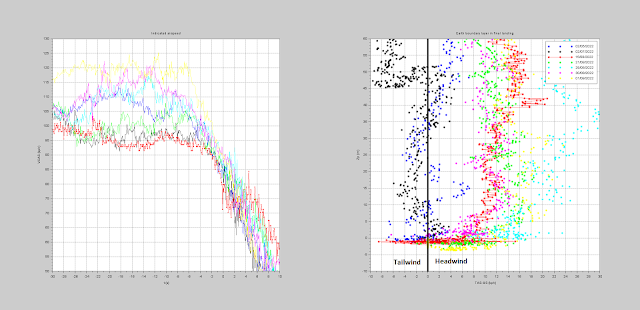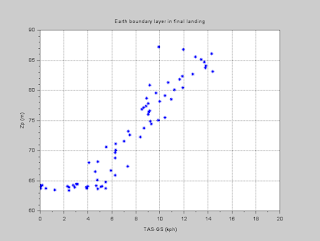As XC Vario is recording the different pressures available on my glider, namely static PS, dynamic pressure Q & TE probe PTE, it is possible to study them.
Anemometric calibration curve of LS6 being quite good, as showing low error of IAS vs CAS, it means in particular than static measuremnt is of good quality.
 |
| DLR-measured anemo calibration curves for LS6 (1986) |
As a result, it is possible to build TE pressure coefficient with a reasonable confidence in the absolute level. TE pressure coefficient is defined as follows :
CP_TE=(PTE-PS)/Q
To have a good compensation antenna, value for this pressure coefficient should be CP_TE=-1.
Now, let's see what we measure in flight on the LS6, which is fitted with a venturi-type compensation antenna.
First, a phugoid manoeuver is showing a good range of speed with minimum stick input. Below is plotted the antenna pressure coefficient as function of indicated airspeed.
 |
| TE pressure coefficient in phugoid |
It can be observed that my antenna is not a perfect, as being 5 to 10% off vs desired value for typical cruise speeds.
As pressure coefficient is more negative than desired, it means this antenna has a trend to over-compensate altitude variation for speed variations. In a typical pull up on a modern glider, speed variation vs geometric altitude variation corresponds to a ~10m/s correction term, meaning a 5% error on the coefficient makes ~0.5m/s error on variometer reading.
As well to ne noted : when reaching low speed range, the antenna over-compensation behavior is increasing.
In real life, TE pressure is exposed to many perturbations : turbulence, sideslip, angle of attack, pilot input, etc... Ideally the local pressure coefficient would stay imune to those parameter, but this is actually not the case. As a result, TE pressure is affected by some measurement noise, that is at the end polluting variometer readings.
Below is the TE pressure coefficient recorded over 30min during one of my XC-country flight, showing an example of "real life" situation.
 |
| TE pressure coefficient while flying in southern alps, from Col de Vars to Crete de Peyrolle |
In contrast to the relatively ideal phugoid manoeuver, it can be observed that pressure coefficient versus speed is quite noisy, especially for low speed, with either over- or under-compensation behavior.
When on top we isolate points corresponding to wings levels (in green), it appears that the low speed noise is very much related to circling phase. In thermals, probability for turbulence or for non symetric flight is higher, both likely to expose TE probe to undue perturbations. Noise is less in straight flight, but does exist as well.
Below is a collection of time slices analysed from a TE antenna characteristic, to start getting a sense of statistics & patterns. From left to right & top to bottom : clound street flying, low altitude hang flying, High mountaign area flying, low start over hill in weak lift, small wave flying, landing
Performing similar measurement for different antenna would be interesting, but was not done so far.
As a final note, it can be either concluded I have a bad TE antenna, or that reliable variometer without an antenna would be a benefit...
















